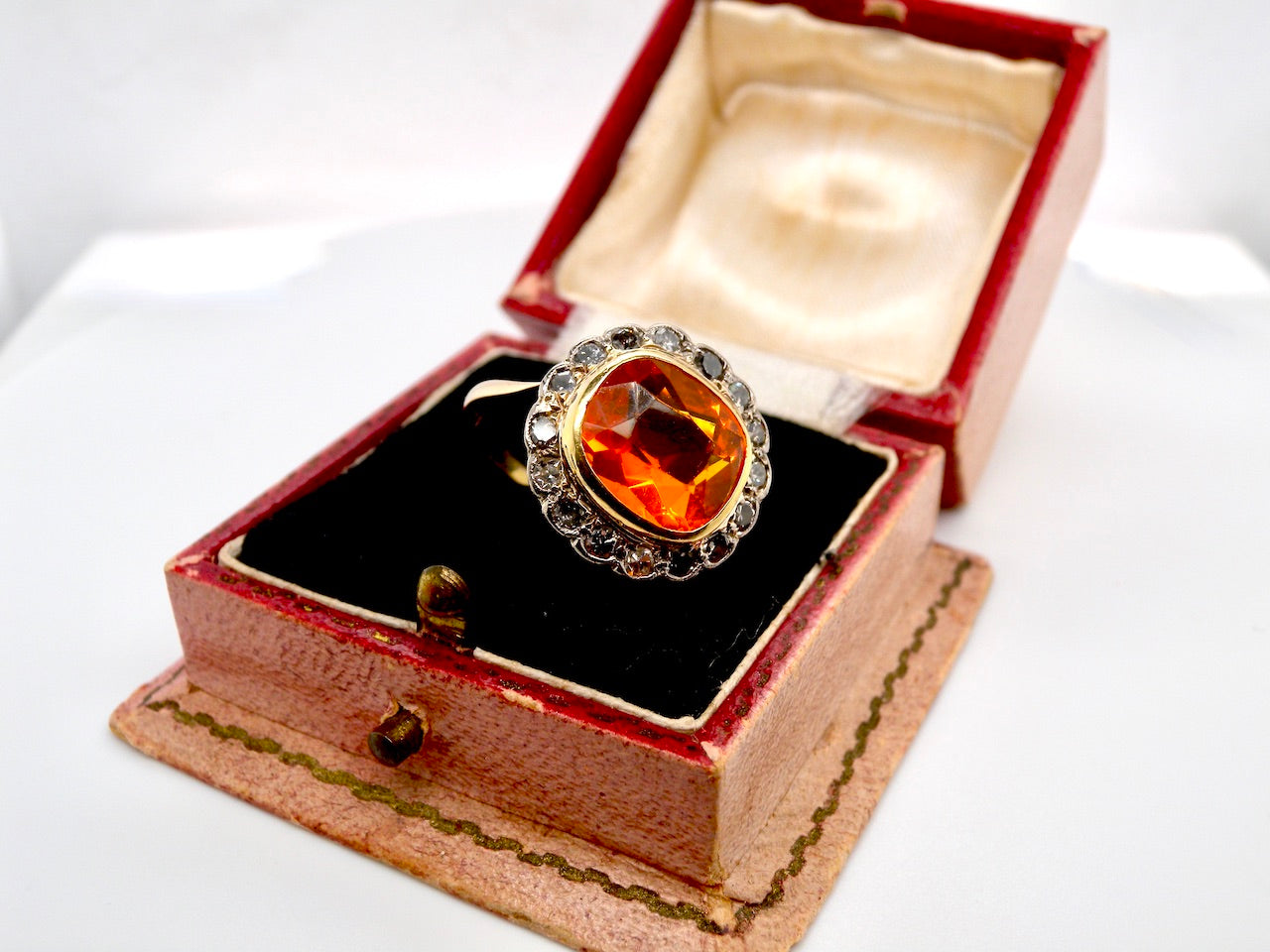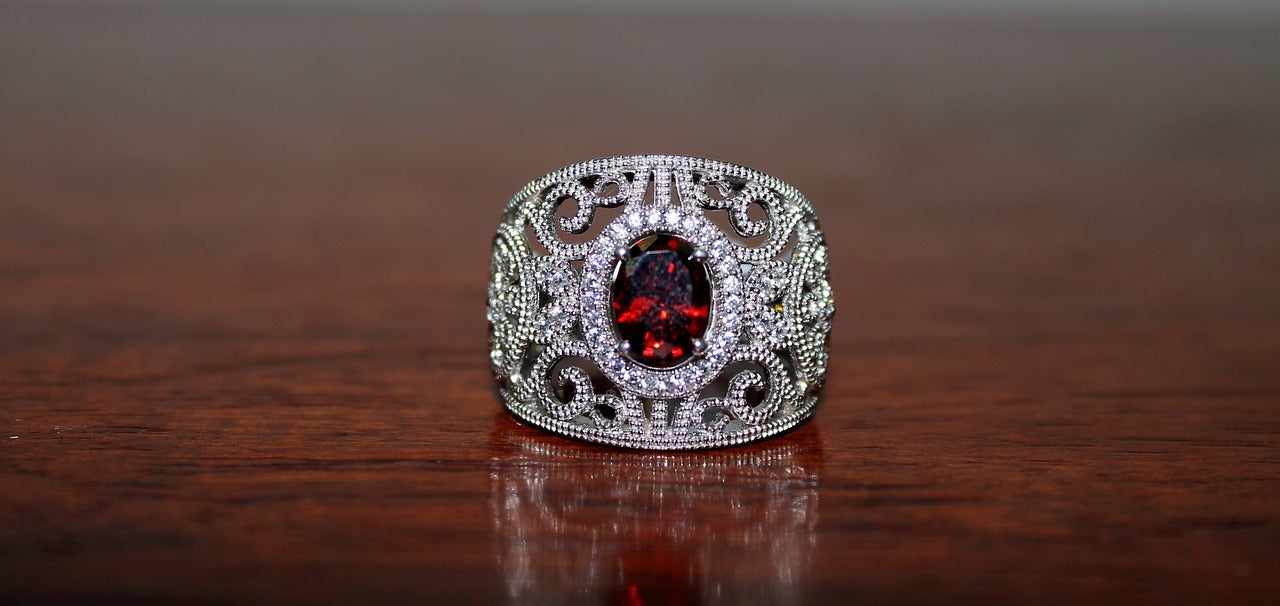One of the first antique pieces I ever held as a young apprentice was a Victorian garnet cluster ring. The stones glowed like drops of red wine, tightly packed together to create the effect of one brilliant surface. It wasn’t the most expensive item in the shop, but it left an impression on me that’s never faded. That’s the magic of garnets: they may not always command the same prestige as rubies or sapphires, but their history and beauty run deep.
At Charles Hart Jewellers, our family has been trading in fine jewellery for more than 200 years. In that time, we’ve seen garnets pass through our hands in almost every form imaginable: Roman-style intaglio rings, Georgian collet-set examples, Victorian brooches sparkling with dozens of Bohemian stones. Every garnet has a story and tracing their history is like tracing the history of jewellery itself.
Garnets in the Ancient World

The word “garnet” comes from the Latin granatum, meaning pomegranate. It’s a fitting name: the tiny red crystals found in the earth reminded early miners of pomegranate seeds.
The Egyptians used garnets as beads and amulets as early as 3000 BC. The Romans loved them for intaglios carved gems used as seals. I once examined a Georgian revival ring featuring a garnet intaglio in a Roman style; even though it was centuries younger than the originals, it showed just how enduring the stone’s classical appeal has been.
Medieval Beliefs and Symbolism
During the Middle Ages, people believed garnets carried protective powers. Knights heading out on Crusades sometimes stitched them into clothing or armour, hoping the stones would guard against wounds. In the church, bishops and priests used them as symbols of Christ’s sacrifice the red colour made that connection obvious. Even today, when I show a Victorian garnet cross to a customer, I’ll often hear them say it “feels spiritual.” That sense of courage and devotion has stuck with the stone for centuries.
This association with protection and faith gave garnets a symbolic weight that still lingers. Collectors today often tell us they’re drawn to garnets not just for their colour, but because they feel somehow more “meaningful” than other stones.

The Victorian Garnet Craze
By the mid-19th century, garnets were everywhere in European jewellery. Bohemian mines produced stones in abundance, and jewellers created elaborate pieces where dozens sometimes hundreds of small garnets were set tightly together. The result was dazzling: fiery, almost metallic surfaces that glittered under candlelight.
We’ve handled countless examples of these Victorian garnet clusters in our shop. They were a favourite engagement gift at the time, especially for families who couldn’t afford rubies. Even now, they remain one of the most accessible entry points for collectors of antique jewellery.
20th-Century Garnets and Beyond
By the early 20th century, garnets had started to take a back seat. Diamonds and sapphires were stealing the limelight, but garnets never really disappeared. In fact, during the Art Deco years they found a new stage. Jewellers loved pairing their rich red with the crisp geometry of white gold and diamonds. The contrast was bold, dramatic, and very much of its time.
I remember one piece in particular a 1930s brooch with a deep red cushion-cut garnet framed by slim baguette diamonds. The lines were sharp, almost architectural, and the stone itself glowed warmly against all that icy brilliance. It was proof, to me at least, that garnets have a way of adapting to any fashion without losing their character.
Today, garnets continue to attract collectors. They’re durable enough for everyday wear, available in a wider colour range than many people realise (greens, oranges, and even rare purplish tones), and remain far more affordable than many other historic gems.
Collecting Garnet Jewellery
Look for Victorian clusters: These remain the most iconic form of antique garnet jewellery, especially pieces with their original fittings.
Examine for wear: Garnets are hard enough to last centuries, but heavy daily wear can leave abrasions on the surface. A well-preserved stone is worth more.
Some of my favourite garnet pieces are the Georgian rings. They were usually set in closed-back mounts, which gave the stones a mysterious, almost glowing depth. Modern copies never quite capture that look you can tell when you’re holding the real thing.
With garnets, the design often matters as much as the stone itself. A simple solitaire has its charm, but the real show-stoppers are the elaborate cluster rings and brooches where dozens of small stones are set close together. Under the right light, they almost shimmer like hot coals.
FAQs About Garnets
Q: Are garnets valuable?
A: They can be. You won’t usually see them reach the same prices as rubies or emeralds, but collectors will pay a strong premium for the right piece. A well-kept Victorian Bohemian cluster or an early Georgian ring can fetch far more than people expect. In fact, I’ve seen customers surprised when a garnet brooch outperformed a sapphire piece at auction simply because of its rarity and craftsmanship.
Q: How do I know if my garnet is real?
A: Natural garnets usually show small inclusions under magnification. In our workshop, we’ve tested hundreds and authenticity is best confirmed by an experienced jeweller.
Q: Why did Victorians love garnets so much?
A: Garnets offered the drama and richness of ruby at a fraction of the cost. Their fiery sparkle under gaslight made them perfect for evening wear.
Q: Can garnets be used in engagement rings?
A: Yes, and many were in the past. They’re slightly softer than diamonds or sapphires, so they require more care, but we’ve sold 19th-century garnet rings that have lasted beautifully.
Q: Are garnets only red?
A: Not at all. While red is the classic colour, garnets also appear in orange (spessartite), green (tsavorite), and even rare purplish tones. Antique jewellery most often features deep red stones, particularly from Bohemian sources.
Final Thoughts
When you hold a garnet ring from the 1800s in your hand, you’re not just looking at a gemstone you’re holding a little piece of history. I’ve seen Roman-style intaglios, Victorian brooches packed with Bohemian stones, and even 1930s Art Deco pieces where garnets were given a bold, modern edge. The appeal isn’t about price; it’s about character. Garnets have always had that and collectors know it.In our shop, garnets have never really gone out of style. One week it might be a Georgian ring with a closed-back mount, the next a Victorian cluster sparkling like a handful of embers. Every piece we choose has something about it that catches the eye or the imagination. That’s why they’ve lasted this long.
In our shop, garnets have never really gone out of style. One week it might be a Georgian ring with a closed-back mount, the next a Victorian cluster sparkling like a handful of embers. Every piece we choose has something about it that catches the eye or the imagination. That’s why they’ve lasted this long.
If you’ve ever been tempted by garnets, now’s the time to look closer. Our collection at Vintage Tom is full of pieces with stories to tell some fiery, some subtle, but all with that unmistakable glow that’s kept collectors coming back for centuries.
You can view our fine collection of Garnet Jewellery here
You may also like:Antique Jewellery Investment Guide



